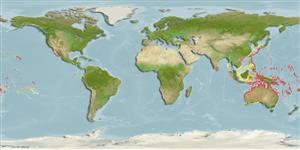>
Eupercaria/misc (Various families in series Eupercaria) >
Labridae (Wrasses) > Bodianinae
Etymology: Choerodon: Greek, choiros = a pig + odous = teeth (Ref. 45335); referrring to the prominent anterior canines of the species in this genus (Ref. 116605).
Eponymy: Dr David Starr Jordan (1851–1931) was a leading American ichthyologist, physician, educator, peace activist and believer in eugenics; moreover, he was founding President of Stanford University. [...] (Ref. 128868), visit book page.
More on author: Snyder.
Environment: milieu / Klimaatzone / Diepte / distribution range
Ecologie
marien rifbewoner; diepte 15 - 30 m (Ref. 9710), usually 20 - 30 m (Ref. 9710). Tropical
Western Pacific: Ryukyu Islands south to Western Australia and the Great Barrier Reef and east to Samoa and Tonga (Ref. 53797).
Grootte / Gewicht / Leeftijd
Maturiteit: Lm ? range ? - ? cm
Max length : 17.0 cm TL mannelijk / geslacht onbekend; (Ref. 2334)
Dorsale stekels (totaal) : 13; Dorsale zachte stralen (totaal) : 7; Anale stekels: 3; Anale zachte stralen: 10. A large pale spot situated below posterior end of dorsal-fin base, bordered anteriorly by a broad dark band tapering anteroventrally toward pectoral-fin base (band extending as dusky segment around ventral and posterior side of pale spot). Dorsal edge of caudal fin dark in adults. (Ref 9823)
Body shape (shape guide): fusiform / normal; Cross section: oval.
Adults are usually found on substrata of sand, rubble, or small coral heads near reefs (Ref. 2334). Oviparous, distinct pairing during breeding (Ref. 205).
Levenscyclus en paargedrag
Maturiteit | Voortplanting | Paaien | Eieren | Fecunditeit | Larven
Oviparous, distinct pairing during breeding (Ref. 205).
Randall, J.E., G.R. Allen and R.C. Steene, 1990. Fishes of the Great Barrier Reef and Coral Sea. University of Hawaii Press, Honolulu, Hawaii. 506 p. (Ref. 2334)
Status op de Rode Lijst van het IUCN (Ref. 130435: Version 2025-1)
Gevaar voor de mens
Harmless
Gebruik door de mens
Visserij: commercieel; Aquarium: Commercieel
Tools
Speciale rapporten
Download XML
Internetbronnen
Estimates based on models
Preferred temperature (Ref.
123201): 22.8 - 28.7, mean 27 °C (based on 130 cells).
Fylogenetische diversiteitsindex (Ref.
82804): PD
50 = 0.5000 [Uniqueness, from 0.5 = low to 2.0 = high].
Bayesian length-weight: a=0.01288 (0.00577 - 0.02877), b=3.05 (2.85 - 3.25), in cm total length, based on LWR estimates for this (Sub)family-body shape (Ref.
93245).
Trofisch niveau (Ref.
69278): 3.5 ±0.37 se; based on food items.
Weerstandsvermogen (Ref.
120179): Hoog, minimale populatieverdubbelingstijd minder dan 15 maanden (Preliminary K or Fecundity.).
Fishing Vulnerability (Ref.
59153): Low vulnerability (10 of 100).
🛈
Nutrients (Ref.
124155): Calcium = 80.1 [48.0, 133.6] mg/100g; Iron = 0.697 [0.410, 1.279] mg/100g; Protein = 18.5 [15.6, 20.7] %; Omega3 = 0.155 [0.101, 0.239] g/100g; Selenium = 23.7 [14.4, 42.2] μg/100g; VitaminA = 139 [44, 507] μg/100g; Zinc = 1.64 [1.13, 2.55] mg/100g (wet weight);
